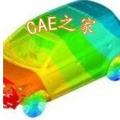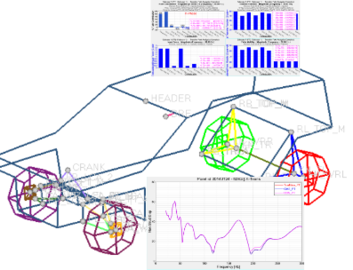分享个材料数据库

主要包括以下内容:
Unit Converter
Acoustics Air Psychrometrics Basics Combustion Drawing Tools Dynamics Economics Electrical Environment Fluid Mechanics Gases and Compressed Air HVAC Systems Hydraulics and Pneumatics Insulation Material Properties Mathematics Mechanics Miscellaneous Physiology Piping Systems Process Control Systems Pumps Sanitary Drainage Systems Standard Organizations Statics Steam and Condensate Thermodynamics Water Systems 
Acoustics
Room acoustics and acoustic properties. decibel A, B and C calculations. Noise Rating (NR) curves. Sound transmission through walls. Calculate sound pressure, sound intensity and sound attenuation.
Related Documents
Air - Speed of Sound vs. Temperature
Speed of sound in air at standard atmospheric pressure with temperatures ranging -40 to 1000 °C (-40 to 1500 °F) - Imperial and SI Units.
Decibel
Logarithmic unit used to describe ratios of signal levels - like power or intensity - to a reference level.
Decibel A, B and C
Sound pressure filters that compensates for the hearing sensed by the human ear.
Fans - Noise Power Generation
The sound generated by a fan depends on the motor power, the volume capacity, the static pressure increase and the discharged volume.
Floor Vibrations
Human activities like walking, running and dancing - and operating machines - can introduce floor vibrations due to resonance.
Gases - Speed of Sound
Speed of sound in some gases at zero degrees Celsius and atmospheric pressure.
Lined Sheet-Metal Ducts - Sound Attenuation
Noise attenuation in rectangular straight, lined, sheet metal ducts.
Liquids - Speed of Sound
Speed of sound in common fluids like water, glycerol, kerosene and more.
Maximum Sound Pressure Levels in Rooms
Maximum recommended sound pressure levels in rooms like kindergartens, auditoriums, libraries, cinemas and more.
Noise - Acceptable dBA Level
Acceptable noise - dBA - level at typical common locations.
Noise - EPA Protective Levels
The noise level should not exceed certain values to protect public health and welfare.
Noise - Maximum Daily Dose Level
Maximum daily noise dose level when exposed to periods with different levels.
Noise - Recommended Exposure Limits (REL)
The NIOSH noise Recommended Exposure Limit - REL - for occupational noise
Noise Criterion (NC) - Free Online Calculator
Calculate Noise Criterion (NC) from octave band pressure levels.
Noise Criterion (NC) Levels: Definitions, Standards & Calculator
Noise Criterion - NC - level is a standard uesd to describe the relative loudness of a space within a range of frequencies.
Noise Criterion vs. Noise Rating and dB(A)
Comparing Noise Criterion (NC, NCB, RNC) to Noise Rating (NR) and dB(A).
Acoustics
Room acoustics and acoustic properties. decibel A, B and C calculations. Noise Rating (NR) curves. Sound transmission through walls. Calculate sound pressure, sound intensity and sound attenuation.
ADVERTISEMENT
Related Documents
Air - Speed of Sound vs. Temperature
Speed of sound in air at standard atmospheric pressure with temperatures ranging -40 to 1000 °C (-40 to 1500 °F) - Imperial and SI Units.
Decibel
Logarithmic unit used to describe ratios of signal levels - like power or intensity - to a reference level.
Decibel A, B and C
Sound pressure filters that compensates for the hearing sensed by the human ear.
Fans - Noise Power Generation
The sound generated by a fan depends on the motor power, the volume capacity, the static pressure increase and the discharged volume.
Floor Vibrations
Human activities like walking, running and dancing - and operating machines - can introduce floor vibrations due to resonance.
Gases - Speed of Sound
Speed of sound in some gases at zero degrees Celsius and atmospheric pressure.
Lined Sheet-Metal Ducts - Sound Attenuation
Noise attenuation in rectangular straight, lined, sheet metal ducts.
Liquids - Speed of Sound
Speed of sound in common fluids like water, glycerol, kerosene and more.
ADVERTISEMENT
Maximum Sound Pressure Levels in Rooms
Maximum recommended sound pressure levels in rooms like kindergartens, auditoriums, libraries, cinemas and more.
Noise - Acceptable dBA Level
Acceptable noise - dBA - level at typical common locations.
Noise - EPA Protective Levels
The noise level should not exceed certain values to protect public health and welfare.
Noise - Maximum Daily Dose Level
Maximum daily noise dose level when exposed to periods with different levels.
Noise - Recommended Exposure Limits (REL)
The NIOSH noise Recommended Exposure Limit - REL - for occupational noise
Noise Criterion (NC) - Free Online Calculator
Calculate Noise Criterion (NC) from octave band pressure levels.
Noise Criterion (NC) Levels: Definitions, Standards & Calculator
Noise Criterion - NC - level is a standard uesd to describe the relative loudness of a space within a range of frequencies.
Noise Criterion vs. Noise Rating and dB(A)
Comparing Noise Criterion (NC, NCB, RNC) to Noise Rating (NR) and dB(A).
ADVERTISEMENT
Noise Exposure - Permissible Levels and Duration
Exposure to noise should be controlled so that it is less than a maximum combination of exposure level and duration.
Noise from Machines - Enclosures and Sound Pressure Level Reductions
Barriers and enclosures to reduce noise sound pressure levels from machines.
Noise generated by Fans - Blade Pass Frequency (BPF)
TheBlade Pass Frequency noise generated by a fan can be very intense and varies with the number of blades and the rotation velocity.
Noise generated by Road Traffic
Estimate noise level generated by traffic.
Noise generated in Air Ducts
Estimate noise generated by air flow in ducts.
Noise generated in Blade Dampers
Sound power noise generated by blade dampers in ventilation systems.
Noise Rating (NR) - Free Online Calculator
An online Noise Rating (NR) calculator.
Notes, Octaves and Frequencies
Frequencies vs. notes and octaves.
ADVERTISEMENT
NR - the Noise Rating Curve
The Noise Rating (NR) Curve used to determine acceptable indoor environments for hearing preservation, speech communication and annoyance.
Octave Band Frequencies
The octave and the 1/3 octave band frequencies.
Outdoor Ambient Sound Pressure Levels
Outdoor ambient sound pressure levels (dBA) in rural and urban business and industrial environments with or without limited traffic.
PNC - the Preferred Noise Criterion
A noise measurement system for continuous or ambient noise in indoor environments.
Preferred Noise Criterion (PNC) - Calculator
An online Preferred Noise Criterion (PNC) calculator.
Propagation of Outdoor Sound - Partial Barriers
The transmission of outdoor sound through and around barriers - the Fresnel Number.
Propagation of Sound Indoors - the Room Constant
In a room the sound or noise will reach the receiver as direct and reverberant sound.
Propagation of Sound Outdoors - Attenuation vs. Distance
The propagation of outdoors sound vs. distance and attenuation.
RC - the Room Criteria
The Room Criteria (RC) is used to measure background noise in buildings for frequencies ranging 16 to 4000 Hz.
Required Voice Level at Distance
Distance and perception of voice.
Signals - Adding Decibels
The logarithmic decibel scale is convenient when adding signal values like sound power, pressure and others from two or more sources.
SIL - the Speech Interference Levels
Background noise frequencies that interferes with speech.
Solids and Metals - Speed of Sound
Speed of sound in solids and metals like aluminum, brass, concrete and more.
Sound - Abatement vs. the Distance from Source
The disruption of the sound pressure wave and the reduction of noise is called attenuation - Sound Pressure Level vs. distance calculator.
Sound - Attenuation and Speed vs. Sound Frequency and Air Humidity
The speed and attenuation of sound in moist air varies with sound frequency and air humidity.
Sound - Attenuation and the Directivity Coefficient
The attenuation in a room depends on the location of the sound source and the receiver - and the room constant.
Sound - Doppler Effect
The doppler effect is the change in sound frequency due to the relative motion between a source and a listener.
Sound - Frequency, Wavelength and Octave
An introduction to the nature of sound with frequencies, wave-lengths and octaves.
Sound - Hearing Threshold vs. Age

Shift in hearing threshold for men and women vs. age.
Sound - Ldn - Day and Night Level
The EPA A-weighted sound level day and night equivalent definition - Ldn - for a 24 hour period.
Sound - Leq - Equivalent Level
The EPA Equivalent Sound Level - Leq - quantifies the noise environment to a single value of sound level for any desired duration.
Sound - Ls - Exposure Level
The EPA Sound Exposure Level - Ls - describes the noise from a variable source.
Sound - Reverberation Time
The sound reverberation time indicates how long it takes until the sound pressure level in a room is decreased with 60 dB.
Sound - Room Absorption Characteristics
Mean absorption coefficients and reverberation times in typical rooms.
Sound - Room Absorption Coefficients
Room sound absorption and absorption coefficients for common materials like plaster walls, brickwork, plywood panels and more.
Sound - Room Attenuation in Direct Sound Fields
Room size, absorption characteristics - and attenuation in direct sound fields.
Sound Attenuation - Duct split to Terminals
Estimating sound attenuation where ducts splits to terminals.
Sound Attenuation - Main Duct to Branch Ducts
Sound attenuation from main ducts to branch ducts.
Sound Attenuation in Duct Elbows
Noise attenuation in duct elbows by reflected sound.
Sound Attenuation in Ducts due to End Reflection
Low frequency noise transferred from main duct to end terminals is reflected back to main duct.
Sound Intensity
Acoustic power of sound per unit area.
Sound Intensity, Power and Pressure Levels
Introduction to decibel, sound power, intensity and pressure.
Sound Level - Online Calculator
Calculate sound level, pressure and intensity.
Sound Power
Sound power from sources like fans, jet engines, cars, humans and more.
Sound Pressure
Sound Pressure is the force of sound on a surface perpendicular to the propagation of sound.
Sound Pressure Level - OSHA A-Weighted per Day
OSHA maximum A-weighted sound pressure levels allowed per day.
Sound Propagation - the Inverse Square Law
Doubling of the distance from a noise source reduces the sound pressure level with 6 decibel.
Sound Transmission through Duct Walls
Sound transmission from ducts to surrounding rooms.
Sound Transmission through Flanking Paths
Sound transmitted through duct walls, floors and ceilings.
Sound Transmission through Massive Walls or Floors
Sound transmission and attenuation in building elements like massive concrete walls or floors.
Speed of Sound - Equations
Calculate the speed of sound (the sonic velocity) in gases, fluids or solids.
Speed of Sound - Online Calculator
A free online speed of sound calculator.
Subjective Effect of Change in Sound Pressure Level
Change in sound pressure level and the subjective human perception.
Unlined Sheet-Metal Ducts - Sound Attenuation
Noise attenuation in unlined sheet-metal ducts.
Use of Telephones in Noisy Areas
Satisfactory, difficult and impossible noise levels for telephone use in noisy areas.
Ventilation Systems - Acoustic Calculation Procedure
Acoustic noise calculation procedure HVAC systems.
Ventilation Systems - Classification of Noise Reduction Silencers
Noise in a ventilation system can be reduced by reactive, diffuser type, active and/or dissipative silencers.
Water - Speed of Sound vs. Temperature
Speed of sound in water at temperatures ranging 32 - 212°F (0 - 100°C) - Imperial and SI units.
ADVERTISEMENTSearch
Search is the most efficient way to navigate the Engineering ToolBox.
Popular internal searches in the Engineering ToolBox
Our Mission
The Engineering ToolBox provides a wide range of free tools, calculators, and information resources aimed at engineers and designers. It offers detailed technical data and calculations for various fields such as fluid mechanics, material properties, HVAC systems, electrical engineering, and more.
The site includes resources for common engineering tasks, such as calculating physical properties (e.g., density, viscosity, thermal conductivity), converting units, and designing systems like heating and water distribution.
With sections on everything from acoustics to hydraulics, it serves as a comprehensive tool for both students and professionals in technical and engineering disciplines.
Engineering ToolBox - SketchUp Extension - Online 3D modeling!






